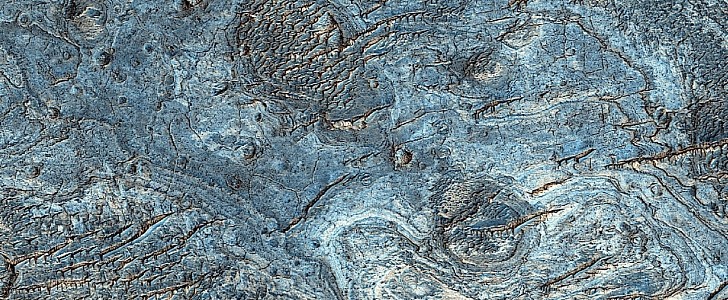The advancements made in space exploration technology presently allow us to see the celestial bodies in ways we weren’t capable of seeing them before. And with Mars being the focus of so many exploratory missions, we now have the chance of experiencing the place in all sorts of new ways, and that makes the planet even more appealing for those wishing to one day go there.
Generally seen as a piece of reddish, desert rock, Mars is much more fascinating than that. With the help of the HiRISE camera in orbit around the planet, and its filters and additional hardware, we humans have been able for the past few years to experience the planet in ways that were impossible to previous generations.
One of the ways HiRISE uses to peel the veil of mystery off Mars is the use of color enhancement. By applying this technique, regions that otherwise might seem boring and flat get exposed as true sources of bewilderment. Kind of like the bit of alien world we have here.
What you’re looking at is a slice of the plains located south of Valles Marineris, one of the largest canyons in the solar system. Whereas the canyon system is impressive in size (4,000 km/2,500 miles long, 200 km/120 miles wide, and 7 km/4.3 miles deep) and appearance (it looks like a huge scar across one side of the planet), the plains are quite boring when looked at with no help.
That changes though when color enhancement is performed, and we get a place with blueish tint that shows impossible to count cracks and crevices, looking not unlike a cross-section of a long-dead tree.
According to people over at NASA and the University of Arizona, who are constantly studying these images, the cracks, crevices, and other features may very well be “small channels suggesting water flow, craters, and indurated sand dunes.”
This image was captured by HiRISE back in 2008 from an altitude of 256 km (159 miles).
One of the ways HiRISE uses to peel the veil of mystery off Mars is the use of color enhancement. By applying this technique, regions that otherwise might seem boring and flat get exposed as true sources of bewilderment. Kind of like the bit of alien world we have here.
What you’re looking at is a slice of the plains located south of Valles Marineris, one of the largest canyons in the solar system. Whereas the canyon system is impressive in size (4,000 km/2,500 miles long, 200 km/120 miles wide, and 7 km/4.3 miles deep) and appearance (it looks like a huge scar across one side of the planet), the plains are quite boring when looked at with no help.
That changes though when color enhancement is performed, and we get a place with blueish tint that shows impossible to count cracks and crevices, looking not unlike a cross-section of a long-dead tree.
According to people over at NASA and the University of Arizona, who are constantly studying these images, the cracks, crevices, and other features may very well be “small channels suggesting water flow, craters, and indurated sand dunes.”
This image was captured by HiRISE back in 2008 from an altitude of 256 km (159 miles).






